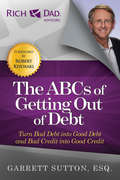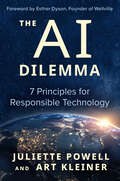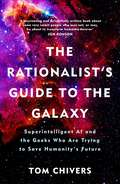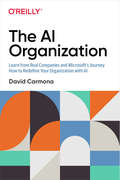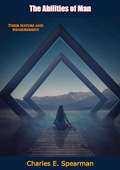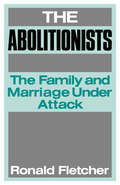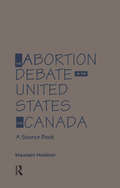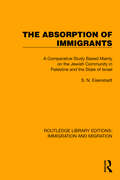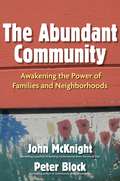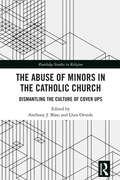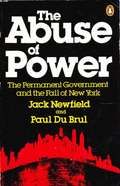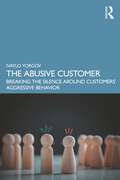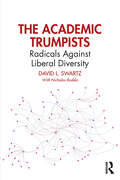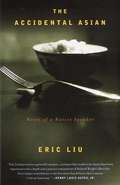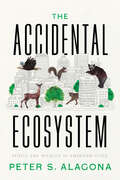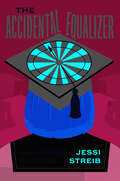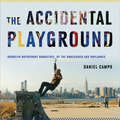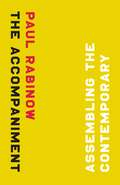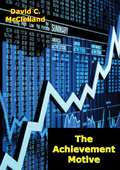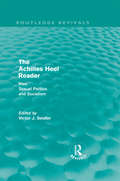- Table View
- List View
The ABCs of Getting Out of Debt
by Garrett Sutton<p>In difficult times, debt can be a matter of life and death, happiness and despair. Controlling your debt can bring order and calm. Mastering debt can bring wealth and success. As bestselling Rich Dad/Poor Dad author Robert Kiyosaki says, “Good debt makes you rich and bad debt makes you poor.” <p>The ABCs of Getting Out of Debt provides the necessary knowledge to navigate through a very challenging credit environment. A Rich Dad’s Advisor and best selling author of numerous business books, Garrett Sutton, Esq. clearly writes on the key strategies readers must follow to get out of debt. Unlike other superficial offerings, Sutton explores the psychology and health effects of debt. From there, the reader learns how to beat the lenders at their own game, and how to understand and repair your own credit. Using real life illustrative stories, Sutton shares how to deal with debt collectors, avoid credit scams, and win with good credit.</p>
The ABCs of Structured Discovery Cane Travel for Children (Critical Concerns In Blindness)
by Merry-Noel ChamberlainStructured Discovery Cane Travel (SDCT) is an Orientation and Mobility (O&M) curriculum which focuses on the foundational techniques necessary to develop future independence for students who are blind or visually impaired. The ABCs of Structured Discovery Cane Travel for Children addresses essential non-visual concept development, techniques and mobility skills needed to travel efficiently, gracefully and safely within a myriad of natural environments while using the long, white cane with a metal tip as the primary mobility tool. This curriculum utilizes transformational knowledge and problem-solving opportunities through teachable moments to develop personal reflection and mental mapping which can be utilized post instruction. These students maximize their cognitive intrinsic feedback while completing everyday mobility tasks. Parents and instructors of children who are blind or visually impaired will comprehend the essentials of SDCT by reading The ABCs of Structured Discovery Cane Travel for Children; in addition, they will receive a treasure trove of O&M skill-building activities.
The AI Dilemma: 7 Principles for Responsible Technology
by Art Kleiner Juliette PowellThe misuse of AI has led to wrongful arrests, denial of medical care, even genocide-this book offers 7 powerful principles that business can use now to end the harm.AI holds incredible promise to improve virtually every aspect of our lives, but we can't ignore its risks, mishaps and misuses. Juliette Powell and Art Kleiner offer seven principles for ensuring that machine learning supports human flourishing. They draw on Powell's research at Columbia University and use a wealth of real-world examples. Four principles relate to AI systems themselves. Human risk must be rigorously determined and consciously included in any design process. AI systems must be understandable and transparent to any observer, not just the engineers working on them. People must be allowed to protect and manage their personal data. The biases embedded in AI must be confronted and reduced. The final three principles pertain to the organizations that create AI systems. There must be procedures in place to hold them accountable for negative consequences. Organizations need to be loosely structured so that problems in one area can be isolated and resolved before they spread and sabotage the whole system. Finally, there must be psychological safety and creative friction, so that anyone involved in software development can bring problems to light without fear of reprisal. Powell and Kleiner explore how to implement each principle, citing current best practices, promising new developments, and sobering cautionary tales. Incorporating the perspectives of engineers, businesspeople, government officials, and social activists, this book will help us realize the unprecedented benefits and opportunities AI systems can provide.
The AI Does Not Hate You: Superintelligence, Rationality and the Race to Save the World
by Tom Chivers'A fascinating and delightfully written book about some very smart people who may not, or may, be about to transform humanity forever' JON RONSONThis is a book about AI and AI risk. But it's also more importantly about a community of people who are trying to think rationally about intelligence, and the places that these thoughts are taking them, and what insight they can and can't give us about the future of the human race over the next few years. It explains why these people are worried, why they might be right, and why they might be wrong. It is a book about the cutting edge of our thinking on intelligence and rationality right now by the people who stay up all night worrying about it.Along the way, we discover why we probably don't need to worry about a future AI resurrecting a perfect copy of our minds and torturing us for not inventing it sooner, but we perhaps should be concerned about paperclips destroying life as we know it; how Mickey Mouse can teach us an important lesson about how to program AI; and how a more rational approach to life could be what saves us all.
The AI Organization: Learn from Real Companies and Microsoft’s Journey How to Redefine Your Organization with AI
by David CarmonaMuch in the same way that software transformed business in the past two decades, AI is set to redefine organizations and entire industries. Just as every company is a software company today, every company will soon be an AI company.This practical guide explains how business and technical leaders can embrace this new breed of organization. Based on real customer experience, Microsoft’s David Carmona covers the journey necessary to become an AI Organization—from applying AI in your business today to the deep transformation that can empower your organization to redefine the industry.You'll learn the core concepts of AI as they are applied to real business, explore and prioritize the most appropriate use cases for AI in your company, and drive the organizational and cultural change needed to transform your business with AI.
The ASEAN Region in Transition: A Socioeconomic Perspective (Routledge Revivals)
by Abu N. M. WahidFirst published in 1997, this volume features analysis of one of the fastest growing areas in Asia for gross national product, trade and commerce: the Association of South East Asian Nations (ASEAN). Of its members, Singapore has achieved a GDP exceeding Spain, Ireland and New Zealand, with Brunei Darussalam close to that mark. The other four countries, on their current trajectories, are expected to soon join the Newly Industrialized Economies (NIE) of Asia which already include Hong Kong, Taiwan, South Korea and Singapore. This collaboration consists of six analyses of the six member countries of the ASEAN: Brunei’s socio-economic policies, Indonesia’s political and economic reforms, the implementation of the New Economic Policy (NEP) in Malaysia, the development policies in the Philippines, the successful role of socio-economic state intervention in Singapore and the double-digit growth conditions in Thailand.
The Abilities of Man: Their Nature and Measurement
by Charles E. SpearmanDR. T. PERCY NUNN IN THE BRITISH JOURNAL OF PSYCHOLOGY.—“In the book before us, Prof. Spearman claims nothing less than to have supplied psychology with a body of principles comparable with the first principles of physics. It is a large claim, even though confined to the psychology of cognition, and if substantiated will secure for its author an enviable place in the history of science....A work which, whatever place it may ultimately assume, is unquestionably one of signal importance....A very remarkable and perhaps epoch-making book.”THE HON. BERTRAND RUSSELL IN THE NATION AND THE ATHENAEUM.—“A sober and learned, but thoroughly readable discussion....The book is valuable for its wide knowledge, its lucid discussions, and its thoroughly scientific spirit.”THE TIMES LITERARY SUPPLEMENT.—“The whole work is excellent, a model of lucid exposition.”PROF. C. W. VALENTINE IN MIND.—“This volume gives us in convenient compass not only the essential conclusions of some of Prof. Spearman’s valuable researches but a very remarkable additional contribution to the psychology of cognition.”THE DAILY NEWS.—“One of the most important works on psychology we have had for some time....A sound and brilliant piece of exposition.”THE SUNDAY TIMES.—“A book of the highest value.”
The Abolitionists: The Family and Marriage under Attack
by Ronald FletcherIn The Abolitionists (a companion volume to The Shaking of the Foundations) Ronald Fletcher turns his attention to those critics who have advocated the abolition of the family. Blaming the strength of the family for all discontents, they see the family as the deeply entrenched last bastion of an exploitative capitalist society - an obstacle to social progress and a prop for patriarchy. These new critics have exerted a growing influence throughout the 1970s and 1980s, and this is the first book to subject them to a systematic critical appraisal. The Abolitionists is a controversial and impressive defence of the modern family shaped by a century and a half of humane reform.
The Abortion Debate in the United States and Canada: A Source Book
by Maureen MuldoonFirst published in 1991. Over the last twenty-five years or so, the debate on abortion has not moved any closer to resolution in either the United States or Canada. The courts, the legislatures, the pulpits, the classrooms, the hospitals and clinics and the media have provided the forums for this on-going struggle. Two groups of activists have dominated the debate. The opponents of abortion, who are referred to as anti-abortion or pro-life, advocate restrictive policies on abortion while the pro-choice groups direct their attempts to creating a permissive policy that allows a woman to make her own decision. The anti-abortion advocates and the pro-choice advocates alike have learned the skills and developed the strategies to advance their own positions. Whatever legal and public policy gains are made by one side are often countered by moves from their opponents. There is available a vast amount of material related to the topic of abortion. From the extensive and diverse literature, this book draws a collection of relevant materials primarily representing aspects of the sociological, philosophical, religious and legal aspects of the abortion issue. Its purpose is to serve as a source bode for those interested in seeing how the abortion debate has been conducted within the recent past. The book also serves as a reference work for further study.
The Absorption of Immigrants: A Comparative Study Based Mainly on the Jewish Community in Palestine and the State of Israel (Routledge Library Editions: Immigration and Migration #2)
by S.N. EisenstadtThe Absorption of Immigrants (1954) examines the assimilation of immigrants in the Yishuv (the Jewish Community in Palestine) and in the State of Israel. It provides a historical analysis of the social structure of the Yishuv and of the development of the new Israeli society. The book also applies the general framework to the analysis of some main types of modern migrations and a series of tentative conclusions is given which may serve as detailed hypotheses for subsequent inquiries. In this way a comparative study of different types of migrations and absorption of immigrants is built up, and an objective evaluation can be made of the place of an Israeli Society among other communities, and their special ways of absorbing new immigrants.
The Abundant Community: Awakening the Power of Families and Neighborhoods
by Peter Block John McknightThere is a growing movement of people with a different vision for their local communities. They know that real satisfaction and the good life are not provided by organizations, institutions, or systems. No numbers of great CEOs, central offices, or long range plans produce what a community can produce. People are discovering a new possibility for their lives. They have a calling. They are called. And together they call upon themselves. This possibility is idealistic, and yet it is an ideal within our grasp. It is a possibility that is both idealistic and realistic. Our culture leads us to believe that a satisfying life can be purchased. It tells us that in the place where we live, we don't have the resources to create a good life. This book reminds us that a neighborhood that can raise a child, provide security, sustain our health, secure our income, and care for our vulnerable people is within the power of our community. This book gives voice to our ideal of a beloved community. It reminds us of our power to create a hope-filled life. It assures us that when we join together with our neighbors we are the architects of the future where we want to live.
The Abuse of Minors in the Catholic Church: Dismantling the Culture of Cover Ups (Routledge Studies in Religion)
by Lluis Oviedo Anthony J. BlasiThis book offers an academically rigorous examination of the biological, psychological, social and ecclesiastical processes that allowed sexual abuse in the Catholic Church to happen and then be covered up. The collected essays provide a means to better assess systemic wrongdoing in religious institutions, so that they can be more effectively held to account. An international team of contributors apply a necessarily multi-disciplinary approach to this difficult subject. Chapters look closely at the sexual abuse of minors by Roman Catholic clerics, explaining the complexity of this issue, which cannot be reduced to simple misconduct, sexual deviation, or a management failure alone. The book will help the reader to better understand the social, organizational, and cultural processes in the Church over recent decades, as well as the intricate world of beliefs, moral rules, and behaviours. It concludes with some strategies for change at the individual and corporate levels that will better ensure safeguarding within the Catholic Church and its affiliate institutions. This multifaceted study gives a nuanced analysis of this huge organizational failure and offers recommendations for effective ways of preventing it in the future. As such, it will be of keen interest to scholars of Religious Studies, Sociology of Religion, Psychology, Psychiatry, Legal Studies, Ethics, Anthropology, Cultural Studies, History, and Theology.
The Abuse of Power
by Jack Newfield Paul A. DuBrul“This book was written as an act of gratitude and loyalty to New York City by two native sons. The only bias we admit to is a love for this city, and particularly for its neighborhoods. We were born here. We grew up in working-class families in neighborhoods called Bedford Stuyvesant and Elmhurst. The only reason we both have college educations is that the City University was free in 1956. We come from a tradition that believes in paying your debts. Our way of repaying New York City for our free college education is to try and tell the truth about what is happening now to our city. This book was born, four years ago, in our mutual recognition that something was profoundly wrong with New York and that the condition was worsening, despite decades of talk about "reform." The knowledge and the anger in these pages were nourished by day-to-day involvement with the city's small agonies. Welfare mothers with lead-poisoned children. Working-class Polish and Italian families losing their homes of a lifetime for someone else's profit. The unspeakable suffering, and the unspeakable corruption, in the nursing-home industry. A brave and difficult rent strike waged by 50,000 people in Co-op City. These are the people for whom we wrote this book, although many of them will perhaps never read it. We hope, though, that by describing the reality, by naming the names, and by proposing some remedies, we are offering a tool for others to use in liberating New York City in the future. This is the repayment of our debt.” – By Author.
The Abuse of Property (Untimely Meditations #19)
by Daniel LoickA fundamental critique of the current property regime, calling for radical social and political change.In The Abuse of Property, Daniel Loick offers a multifaceted philosophical critique of the concept of property, broadly understood. He argues that property should not be the dominant framework in which human beings regulate the use of things, that property is not the same as use. Property rights, in his view, are not conditions of freedom or justice, but deficient, dysfunctional, and harmful ways of interacting with other people and the natural environment. He dissects not only the classic justifications of property (from John Locke's justification of property as a natural right based on individual freedom to Hegel's justification of property as a form of mutual recognition) but also the classic critiques of property, from Proudhon and Marx up to Adorno and Agamben.Through an innovative critical approach to legal studies, Loick demonstrates how the concept of property, historically applied to things and people and still a linchpin of our distorted relation with the world, forms a direct line from the Occupy movement to Black Lives Matter and beyond.
The Abusive Customer: Breaking the Silence Around Customers’ Aggressive Behavior
by Ivaylo YorgovBreaking the silence around an all-too-common problem, this book offers insights into the triggers of customer aggression against service employees, explores its consequences, and provides practical advice for handling abusive customers and mitigating the damage they inflict. Today, more than half of the world’s population is employed in the service sector. This fundamental economic shift is accompanied by heightened attention to customer service and the ‘customer is always right’ paradigm. But when customers act aggressively, everyone pays a price: frontline employees, their families, their companies, and even the abusive customers themselves. Unlike breezier titles on the subject, this book is based in academic research—exploring the ‘why?’ and ‘when?’ behind abusive behavior—that underpins its practical approach, illustrated with real-world stories from professionals on the front lines of customer service. The book’s useful tools include a sample anti-customer abuse policy and management process, a cheat sheet of practices that work for handling its consequences, a summary of effective service recovery processes and practices, and abuse-handling training list and curriculum templates. Managers and workers in customer-facing roles, in industries such as retail, hospitality, tourism, banking, and contact centers, will welcome this essential resource as part of their efforts to stop aggressive customer behavior, and improve employee morale, job satisfaction, and engagement.
The Academic Trumpists: Radicals Against Liberal Diversity
by David L. SwartzThere has been an outpouring of research on populist conservatism since the advent of the Trump presidency and extreme right movements in Europe. Much less studied, however, is the growing political conservatism in the American academy and how it relates to populist sentiment. The Academic Trumpists addresses a gap in the research literature by looking at the impact of Trumpism on conservative faculty. It compares 109 professors who publicly support Trump to 89 conservative professors who oppose Trump. All 198 function as public intellectuals who advocated publicly their views.Drawing on recent research in the sociology of intellectuals and Pierre Bourdieu’s analytical field perspective, this book offers a fielding political identities and practices framework to show how these two groups of professors (Trumpists and anti-Trumpists) differ in where they teach, their intellectual orientations, their scholarly productivity, their political rationales, where they network with think tanks, scholarly professional associations, and government agencies, and their stances on key controversies surrounding the Trump presidency (Covid-19, the two impeachments, the November 2020 election lost, and the January 6 mob assault on the United States Capitol). The academic Trumpists embrace the right-wing populist wave mobilized by Trump and the conservative critics resist this move. This polarization of views between these two groups of conservative professors is enduring and rooted in two distinct social networks that connect their positions in the academic field to affiliations with conservative think tanks that reinforce their respective political identities and radical right-wing anti-establishment thinking in America more generally.This book will appeal to readers interested in the politics of higher education, the sociology of intellectuals, political sociology, and research on conservative and right-wing populism politics in America today.
The Accidental Asian
by Eric LiuA series of essays by a second generation Chinese American about language, culture and race.
The Accidental Ecosystem: People and Wildlife in American Cities
by Peter S. AlagonaWith wildlife thriving in cities, we have the opportunity to create vibrant urban ecosystems that serve both people and animals.The Accidental Ecosystem tells the story of how cities across the United States went from having little wildlife to filling, dramatically and unexpectedly, with wild creatures. Today, many of these cities have more large and charismatic wild animals living in them than at any time in at least the past 150 years. Why have so many cities—the most artificial and human-dominated of all Earth’s ecosystems—grown rich with wildlife, even as wildlife has declined in most of the rest of the world? And what does this paradox mean for people, wildlife, and nature on our increasingly urban planet? The Accidental Ecosystem is the first book to explain this phenomenon from a deep historical perspective, and its focus includes a broad range of species and cities. Cities covered include New York City, Los Angeles, San Francisco, Pittsburgh, Austin, Miami, Chicago, Seattle, San Diego, Atlanta, Philadelphia, and Baltimore. Digging into the natural history of cities and unpacking our conception of what it means to be wild, this book provides fascinating context for why animals are thriving more in cities than outside of them. Author Peter S. Alagona argues that the proliferation of animals in cities is largely the unintended result of human decisions that were made for reasons having little to do with the wild creatures themselves. Considering what it means to live in diverse, multispecies communities and exploring how human and non-human members of communities might thrive together, Alagona goes beyond the tension between those who embrace the surge in urban wildlife and those who think of animals as invasive or as public safety hazards. The Accidental Ecosystem calls on readers to reimagine interspecies coexistence in shared habitats, as well as policies that are based on just, humane, and sustainable approaches.
The Accidental Equalizer: How Luck Determines Pay after College
by Jessi StreibA startling discovery—that job market success after college is largely random—forces a reappraisal of education, opportunity, and the American dream. As a gateway to economic opportunity, a college degree is viewed by many as America’s great equalizer. And it’s true: wealthier, more connected, and seemingly better-qualified students earn exactly the same pay as their less privileged peers. Yet, the reasons why may have little to do with bootstraps or self-improvement—it might just be dumb luck. That’s what sociologist Jessi Streib proposes in The Accidental Equalizer, a conclusion she reaches after interviewing dozens of hiring agents and job-seeking graduates. Streib finds that luck shapes the hiring process from start to finish in a way that limits class privilege in the job market. Employers hide information about how to get ahead and force students to guess which jobs pay the most and how best to obtain them. Without clear routes to success, graduates from all class backgrounds face the same odds at high pay. The Accidental Equalizer is a frank appraisal of how this “luckocracy” works and its implications for the future of higher education and the middle class. Although this system is far from eliminating American inequality, Streib shows that it may just be the best opportunity structure we have—for better and for worse.
The Accidental Playground: Brooklyn Waterfront Narratives of the Undesigned and Unplanned
by Daniel CampoThe Accidental Playground explores the remarkable landscape created by individuals and small groups who occupied and rebuilt an abandoned Brooklyn waterfront. While local residents, activists, garbage haulers, real estate developers, speculators, and two city administrations fought over the fate of the former Brooklyn Eastern District Terminal (BEDT), others simply took to this decaying edge, transforming it into a unique venue for leisure, creative, and everyday practices. These occupiers and do-it-yourself builders created their own waterfront parks and civic spaces absent every resource needed for successful urban development, including plans, designs, capital, professional assistance, consensus, and permission from the waterfront’s owners. Amid trash, ruins, weeds, homeless encampments, and the operation of an active garbage transfer station, they inadvertently created the “Brooklyn Riviera” and made this waterfront a destination that offered much more than its panoramic vistas of the Manhattan skyline. The terminal evolved into the home turf for unusual and sometimes spectacular recreational, social, and creative subcultures, including the skateboarders who built a short-lived but nationally renowned skatepark, a twenty-five-piece “public” marching band, fire performance troupes, artists, photographers, and filmmakers. At the same time it served the basic recreational needs of local residents. Collapsing piers became great places to catch fish, sunbathe, or take in the views; the foundation of a demolished warehouse became an ideal place to picnic, practice music, or do an art project; rubble-strewn earth became a compelling setting for film and fashion shoots; a broken bulkhead became a beach; and thick patches of weeds dotted by ailanthus trees became a jungle. These reclamations, all but ignored by city and state governments and property interests that were set to transform this waterfront, momentarily added to the distinctive cultural landscape of the city’s most bohemian and rapidly changing neighborhood.Drawing on a rich mix of documentary strategies, including observation, ethnography, photography, and first-person narrative, Daniel Campo probes this accidental playground, allowing those who created it to share and examine their own narratives, perspectives, and conflicts. The multiple constituencies of this waterfront were surprisingly diverse, their stories colorful and provocative. When taken together, Campo argues, they suggest a radical reimagining of urban parks and public spaces, and the practices by which they are created and maintained. The Accidental Playground, which treats readers to an utterly compelling story, is an exciting and distinctive contribution to the growing literature on unplanned spaces and practices in cities today.
The Accommodation of Regional and Ethno-cultural Diversity in Ukraine (Federalism and Internal Conflicts)
by Sabine Kropp Aadne AaslandThe book offers new insights into how ethnicity, language and regional-local identity interact within the context of Ukrainian political reform, and indicates how these reforms affect social cohesion among ethno-cultural groups. While the individual chapters each focus on one or a few facets of the overall research question, together they draw a nuanced picture of the multifaceted challenges to creating and consolidating social cohesion in a nationalizing state. The concept integrates various disciplines, including political science, international relations, law, and sociology. Correspondingly, the contributions are based on various methodological approaches, ranging from legal analysis over media discourse analysis, individual and focus group interviews to analysis of data from a representative population survey. The findings of the in-depth study are discussed within the broader context of comparative research on diversity management and social cohesion in fragmented societies.
The Accompaniment: Assembling the Contemporary
by Paul RabinowIn this culmination of his search for anthropological concepts and practices appropriate to the twenty-first century, Paul Rabinow contends that to make sense of the contemporary anthropologists must invent new forms of inquiry. He begins with an extended rumination on what he gained from two of his formative mentors: Michel Foucault and Clifford Geertz. Reflecting on their lives as teachers and thinkers, as well as human beings, he poses questions about their critical limitations, unfulfilled hopes, and the lessons he learned from and with them. This spirit of collaboration animates The Accompaniment, as Rabinow assesses the last ten years of his career, largely spent engaging in a series of intensive experiments in collaborative research and often focused on cutting-edge work in synthetic biology. He candidly details the successes and failures of shifting his teaching practice away from individual projects, placing greater emphasis on participation over observation in research, and designing and using websites as a venue for collaboration. Analyzing these endeavors alongside his efforts to apply an anthropological lens to the natural sciences, Rabinow lays the foundation for an ethically grounded anthropology ready and able to face the challenges of our contemporary world.
The Aceh Separatism Conflict in Indonesia: The Practice of Governance in Conflict (SpringerBriefs in Political Science)
by Novri SusanThis book is the first to analyse the practice of governance to resolve conflict in the case of Aceh in Indonesia. Combining theoretical discourse on conflict, democracy, and governance, it draws from original field research on the separatist conflict, utilizing a social constructivist approach in collating observations and interviews with political elites from both the Government of Indonesia and the Aceh Independent Movement (GAM). The conflict was an intractable one in which thousand civilians were killed between 1976 and 2006. The author zooms into the 2003 and 2007 period, against the broader context of the political landscape of Indonesia under the Suharto regime. In doing so, the book tackles the challenges presented by intrastate conflicts relating to ethno-religiosity, land use, and separatism. It unpacks the Indonesian political system’s shift from an authoritarian regime to a democratic one, and demarcates the prevalence of state violence in managing conflicts, as exemplified in the Aceh separatism conflict. Relevent to political scientists and scholars in peace, conflict and development studies, this co-published book presents novel sociological insights into Indonesia’s historical, and contemporary, political landscape.
The Achievement Motive
by David C. McClellandThis book contains a summary of research on the achievement motive conducted mainly at Wesleyan University during the period January 1, 1947, to January 1, 1952, under the continuous moral and financial support of the Office of Naval Research. It provides a practicable method of measuring one of the most important human motives, a method, moreover, which in all probability can be applied to other motives with equal success. Secondly, the book contains what we believe to be an important contribution to psychological theory—at least to the theory of motivation. Finally, the book contains a great deal of information about the achievement motive and related variables.In personality theory there is inevitably a certain impatience—a desire to solve every problem at once so as to get the "whole" personality in focus. The authors have proceeded the other way. By concentrating on one problem, on one motive, they have found in the course of their study that they have learned not only a lot about the achievement motive but other areas of personality as well. So they feel that this book can be used as one basis for evaluating the degree to which a "piecemeal" approach to personality is profitable, an approach which proceeds to build up the total picture out of many small experiments by a slow process of going from fact to hypothesis and back to fact again.
The Achilles Heel Reader: Men, Sexual Politics and Socialism (Routledge Revivals)
by Victor J. SeidlerFirst published in 1991, The Achilles Heel Reader brings together key articles from Achilles Heel, the path-breaking and influential magazine of men's sexual politics. It also includes an important introduction by the editor, setting the magazine in its intellectual and historical context. Achilles Heel, first published in 1978, was a magazine which explored positive conceptions of masculinity and the ways in which men can change in response to the challenge of feminism. It sought to persuade men to take responsibility for the power they share as men in relation to women - and to use this responsibility both in their personal relationships and in challenging the political and social institutions and practices that embody such power. This selection covers crucial issues in men's lives - work, sexuality, children, relationships, family, class, sharing the experience of different masculinities - and brilliantly catches the tensions and anxieties of men trying to cope with the interplay between their sexuality and their political commitments. By bringing the personal and the political together The Achilles Heel Reader reconsiders basic questions of socialist theory and practice. It will be of great value to students of sociology, women's studies, politics and cultural studies, as well as those interested in feminism as part of a process of reworking socialism.
